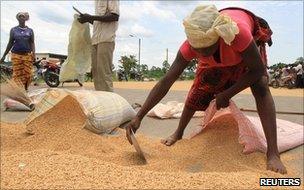Rice traced to single domestication event in China
- Published

Rice is one of the world's most important staple foods
Scientists have shed new light on the origins of rice, one of the most important staple foods today.
A study of the rice genome suggests that the crop was domesticated only once, rather than at multiple times in different places.
Tens of thousands of varieties of rice are known, but these are represented by two distinct sub-species.
The work published in PNAS journal, external proposes that rice was first cultivated in China some 9,000 years ago.
Another theory proposes that the two major sub-species of rice - Oryza sativa japonica and O. sativa indica - were domesticated separately and in different parts of Asia.
This view has gained strong support from observations of large genetic differences between the two sub-species, as well as from several efforts to reconstruct the evolutionary history of the crop.
The japonica type is sticky and short-grained, while indica rice is non-sticky and long-grained.
In the latest research, an international team re-examined this evolutionary history, by using genetic data.
Using computer algorithms, the researchers came to the conclusion that japonica and indica had a single origin because they had a closer genetic relationship to one other than to any wild rice species found in China or India.
They then used a so-called "molecular clock" technique to put dates on the evolutionary story of rice.
Depending on how the researchers calibrated their clock, the data point to an origin of domesticated rice around 8,200 years ago. The study indicates that the japonica and indica sub-species split apart from each other about 3,900 years ago.
The team says this is consistent with archaeological evidence for rice domestication in China's Yangtze Valley about 8,000 to 9,000 years ago and the domestication of rice in India's Ganges region about 4,000 years ago.
"As rice was brought in from China to India by traders and migrant farmers, it likely hybridised extensively with local wild rice," said co-author Michael Purugganan, from New York University (NYU).
"So domesticated rice that we may have once thought originated in India actually has its beginnings in China."
The single-origin model suggests that indica and japonica were both domesticated from the wild rice O. rufipogon.
Several years ago, researchers said they had found evidence for 15,000-year-old burnt rice grains at a site in South Korea, challenging the idea that rice was first cultivated in China. However, the evidence remains controversial in the academic community.